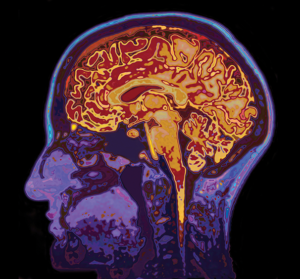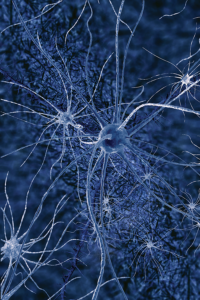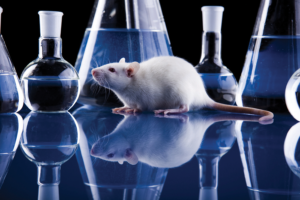The Speed of Thought What the Revolution in Neuroscience Will Mean for Humanism

WE FIND OURSELVES amidst a revolution in neuroscience—the new neuroscience, if you will. In the United States the most visible face of this new science is the BRAIN initiative (Brain Research through Advancing Innovative Neurotechnologies) overseen by the National Institutes of Health. Started by the Obama administration in 2013, the goals of the BRAIN initiative, as stated by its advisory committee, are: “to accelerate the development and application of new technologies that will enable researchers to produce dynamic pictures of the brain that show how individual brain cells and complex neural circuits interact at the speed of thought.”
Other countries are also sponsoring new initiatives in basic neuroscience. For example, the European Union is pursuing the Human Brain Project, which is largely about simulation and informatics. China has a set of initiatives integrated with artificial intelligence, and Japan has a project focused on primate brain studies.
What will these enterprises mean for humanism? Already the brain has become a topic of everyday conversation. Every glossy image of brain activity in the popular press reinforces, subtly but insistently, that our minds are grounded in solid flesh. Every explanation of how a grandparent’s memory is failing because of tiny clumps of protein in his or her brain makes a similar point. The notion that thoughts and feelings occur in physical places, and through chemical processes, is becoming mainstream as the idea of an ethereal “soul” in a parallel reality loses ground. So, what will replace the long-standing Western metaphysics of mind? We need some well-grounded notions of human nature to address the social and political issues facing humanity.
Many people have strong opinions about human nature, but usually can’t provide much evidence for these strong opinions. Humanists look to science to illuminate other challenging issues, such as climate change, so it seems natural to look to science for evidence bearing on human nature. Soon there will be much more solid information about brain processes available to everyone who cares to look; we will be able to refer to verifiable science when talking of human minds in contexts of religion, ideology, and social policy.
Until then, let’s consider why understanding the brain is so hard. After all, scientists have made great progress understanding other organs like the heart and the liver. However, most cells in a heart are contracting at almost the same time. Soon after you drink your morning coffee, most liver cells are gearing up in similar ways to break the caffeine down into theophylline and other chemicals. In the brain no two neurons are acting the same way; in most brain regions, even a cell’s nearest neighbors act almost independently as excitatory or inhibitory forces (see “Brain Facts” section at the bottom of this article). So the dynamics of the brain are perpetually unstable, with each cell competing to influence the others, and inhibitory cells acting to shut them down, rather like a dysfunctional committee. Current measurements like EEG and functional MRI can help identify which regions are working hard. Furthering the analogy, they identify which committees are arguing intensely, but what we really want to record are their discussions. This has been difficult because signals are small and brain tissue is delicate.
Neuroscientists have long been frustrated in their attempts to monitor brain activity. The BRAIN initiative aims to develop new technologies to record systematically from the brain. Neurons signal to each other in less than one hundredth of a second, and communication across the cortex happens on a timescale of a few hundredths of a second. Therefore we need to measure the activity of millions of individual neurons on time scales of less than 1/100 of a second. We’re not there yet, but we’re much closer than we were ten years ago.
The key technology enabling rapid progress in neuroscience is fast optical imaging of brain activity using fluorescent indicators. Researchers put an animal’s brain under a camera and record movies of brain activity at high speed. This procedure mostly uses commodity technology, and therefore this technique improves two- or threefold every year. As of January 2017, leading labs can image 30,000 cells simultaneously and are expecting to record from 100,000 by the end of the year.
So what kinds of things is the new neuroscience discovering? Over the past generation scientists have gained considerable insight by pushing the limits of electrical recordings. We may expect a flood of new insights from the emerging optical technologies (see Brain Facts below).
One of the most intriguing findings of the past two decades is that neural activity patterns impressed by experience, on a brain region called the hippocampus, seem to be replayed during sleep or quiet rest, and this replay is vital for forming memories. If you record from the hippocampus during rest before an activity, the patterns seem random, but if you keep recording during an activity you can identify firing patterns that correspond to particular stages of the activity. Recording again during a period of resting or sleeping shows that these cells replay fragments of those patterns observed during activity. If you interrupt the replay firing patterns corresponding to one specific experience, the subject reacts to a repeat experience as if it has never had it before.
Neuroscientists are now able to decode these patterns of activity and to observe patterns in an animal’s brain that look very much like imagination or anticipation. Researchers at Johns Hopkins University recently trained a rat to find food and then to return to a home location. Typically, the rat would pause at the food location for a second or so before returning home. During this pause the patterns of activity recorded from the brain corresponded to the paths that the animal would take returning home.
Neuroscientists also have some visualization of brain activity when one is struggling to recall a memory. What did you have for breakfast? Where were you when you last said good-bye to your partner? As these memories start to form, neural activity ramps up on the right side of your brain (probably the hippocampus); this activity, synchronized in bursts at a rate of 4-8 Hz, probably reflects messages to and from different areas of the cortex where the fragments of memory are stored. A second or two later, the verbal preparation areas on the left side ramp up in pulses of activity at a higher frequency (70 Hz). Interestingly, memory accuracy depends on the hippocampus engaging with lateral areas, perhaps reality-testing, while vivid memories depend on engagement with medial areas, reflecting more your feelings.
Neuroscientists hope to soon observe the communication processes in detail and to understand what factors enhance or distort the recall process.
Recent data also point to how our brains differ from those of other primates. Superficially, our brains look like scaled-up ape brains. A finer analysis shows that there are no new regions in the human brain, although some regions are re-purposed. Some connections grow further, such as those linking the areas humans use for language, and social brain areas have much stronger connections with the rest of the brain. Some genetic differences slow down brain maturation, and even slow down changes in synapses needed for learning. So our neural machinery of learning in fact works more slowly than in apes, although that allows us to integrate social cues with sensory information about our own experience.
Perhaps most impressively, we now have some empirically grounded ideas about that greatest of mysteries: consciousness. Converging evidence shows that conscious awareness depends on communication between frontal regions and other brain regions during experience. This communication lasts at least a half-second, under normal conditions. You may perceive and react to something unconsciously, and the sensory areas or even recognition areas may be activated. But only when prefrontal areas become activated and in turn reactivate and communicate with sensory or recognition areas do you form a conscious realization.
How situations become familiar is another area being explored. As you get to know a new venue or situation, your hippocampus continually replays where you’ve just been and where you might be going next—about six times per second. We suspect this communication gives rise to our sense of context in action.
As there is with most technical advances, there’s a dark side to neuroscience technologies. In particular, if scientists could read minds there’s the potential for invasion of privacy. Although there have been some startling demonstrations of inferring what someone is looking at or thinking about from brain activity patterns alone, these demonstrations have all been in very controlled settings; these techniques are not robust enough yet to be used in forensic investigations, for example. Complex thoughts and values are much harder to decipher. Nevertheless, most neuroscientists believe that it is only a matter of a decade or so before improved techniques make such methods reliable enough to be used by law enforcement and courts in high-stakes criminal proceedings where other evidence is lacking.
Corporations and political parties are investing heavily in the development of these techniques in order to monitor the brain activity of people exposed to their manipulations and propaganda. Likewise, marketers are jumping on the bandwagon of “neuromarketing,” and so we may expect these groups to engage in ever more effective manipulations.
What kinds of insights from ongoing neuroscience research will enrich humanism in the next decade?
One important contribution of the detailed analysis of brain activity is that we may dissolve the conceptual distinction between emotional and cognitive processes in the brain. Although neuroscientists have often portrayed different brain regions as emotional or cognitive, it’s becoming clear from measurements that almost all areas of the brain participate both in emotion and in cognition—that these are inseparable aspects of brain function. I hope that such integration will help us better understand how dogmatism and unrealistic beliefs depend on our social emotions.
Even now we have some hints of how this might play out. When people think about ideas, or dogmas, in which they feel very confident, the ventromedial prefrontal cortex is most active. This area is crucial for monitoring relationships with other people, and for value judgments. This area is also part of our distinctive evolutionary heritage; it has enlarged in humans much more than other areas when compared with apes’ brains. In 2012, research led by Gary Lewis, now at University of London, found that individual differences in size of the ventro-medial prefrontal cortex were correlated with measures of valuing loyalty, and with concern for authority. Thus it may be that evolution has driven us toward psychological traits that enable group identity to trump individual thinking.
These observations are consistent with and enrich the psychological data that show social identity rather than logic drives most strong beliefs. In principle, neuroscientists could now observe and study the process of how people resolve contradictions between evidence and social belonging, although such studies may be hard to fund in the current political climate.
Although humanists prefer to talk about systemic evils rather than personal evil, it’s arguable that much of the suffering of most people is due to their encounters with a relatively small number of narcissistic, psychopathic, or Machiavellian individuals. What’s different about the brains of sociopaths and Machiavellians? Could these people be identified? What are the implications for a good society? Some dystopian novels and films like Minority Report imagine it may be possible to identify criminals at birth or to predict criminal activity and arrest people before they commit horrific acts. Such scenarios remain a long way off. Nevertheless, even with today’s technology, it’s possible to identify people with substantially higher risks for criminal behavior, psychopathy, or narcissism. Should such technology be used at all? If so, how? These are ethical questions that humanists must address, integrating science with social concern.
Neuroscience should inform how humanists think about key issues over the next few decades. If our brains are really souped-up ape brains rather then divine constructions, then perhaps we need to rethink the human potential for rationality and our rather casual liberal optimism about free choice. My own view is that we’re running human cultural software on ape hardware, and in doing so we’re pushing that hardware to the limits of its performance. So perhaps we shouldn’t be so surprised that rationality breaks down so easily under economic or social stress.
Furthermore, I think it will become clearer that the fundamental difference in our brain is not that we have new parts or special faculties that apes do not. Rather, we are shaped to a much greater extent by our social interactions, so that our social and political environments pervade our thinking. If we humanists want to live in a just society, we need to think more about early childhood experience and about sustaining healthy social relationships among adults.
 Brain Facts
Brain Facts
- Specialized cells called neurons carry out most of the functional work of the brain; each has thousands of branching processes to connect to other neurons.
- You have roughly 85 billion neurons in your brain. Most of them are tiny neurons in the small cerebellum tucked away under the back of your head. In the cerebrum, which most people think of as “the brain,” you have roughly 15 to 20 billion neurons.
- Neurons communicate by sharp fluctuations in voltage informally called spikes. Most neurons excite those to which they connect; a well-connected minority of inhibitory neurons restrain and shape the excitement.
- The time scale of conversation among neurons in a local network is on the order of one hundredth of a second. Fast crude signals can cross your brain in a few hundredths of a second; detailed signals take several times longer.
- Electroencephalography (EEG)—figuratively, “electric head writing”—measures fluctuations in scalp voltage reflecting synchronized activity in the brain underneath.
- Functional magnetic resonance imaging (fMRI) measures the level of blood oxygen in brain tissue; when neurons work hard, the blood vessels nearby expand to bring in more oxygen over a few seconds.
- Optical imaging measures activity of thousands of individual neurons by introducing florescent markers of activity into the brain, and then imaging through a thinned skull, or hole in the skull.
Neuroscience and Animal Rights
 The treatment of animals in neuroscience labs is a lightning rod. The field as a whole has been guilty of some abuses, and reforms have certainly improved treatment. But neuroscience labs feature prominently in the minds of animal rights’ activists, in part because the apparatus often used looks painful in photographs. In fact, the brain has no pain nerves, which is why human brain surgery is done on awake subjects. To prepare an animal for neuro-recording requires intensive preparation—hence neuroscientists become intimate with a small number of animals, and most take care of them well. The less photographed use of millions of animals that die painfully in cancer studies attracts less attention than the thousands used in relatively less painful neuroscience research. As a member of the field, I judge the understanding we gain from neuroscientific experiments, which cannot be obtained by other means, to be of the utmost value.
The treatment of animals in neuroscience labs is a lightning rod. The field as a whole has been guilty of some abuses, and reforms have certainly improved treatment. But neuroscience labs feature prominently in the minds of animal rights’ activists, in part because the apparatus often used looks painful in photographs. In fact, the brain has no pain nerves, which is why human brain surgery is done on awake subjects. To prepare an animal for neuro-recording requires intensive preparation—hence neuroscientists become intimate with a small number of animals, and most take care of them well. The less photographed use of millions of animals that die painfully in cancer studies attracts less attention than the thousands used in relatively less painful neuroscience research. As a member of the field, I judge the understanding we gain from neuroscientific experiments, which cannot be obtained by other means, to be of the utmost value.
